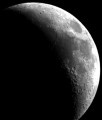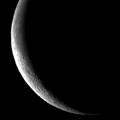Solar System
| PINE MOUNTAIN OBSERVATORY Astrophotography with 8-inch Schmidt-Cassegrain telescope (SCT) “piggybacked” on PMO’s 24-inch telescope. |
| Familiar solar system objects photographed at a magnification of about 100x compared to normal unaided-eye observing. Never observe the Sun directly without the proper filter and observing precautions! |
| Sun and sunspots on October 26, 2013. The Sun is currently near the peak of the 11-year sunspot cycle. As a result of the effect that solar magnetic fields have on the convection of gases in the Sun, sunspots are cooler (and therefore darker) than surrounding areas, although there is a slight increase in the Sun’s total energy output. |
| The Moon on July 13, 2013 and October 31, 2013. This year (2014) will feature two total lunar eclipses, one in April and one in October. |
| Jupiter on October 11, 2013 (with “red spot” just visible), and on January 4, 2014 (with equatorial cloud bands and all four Galilean moons visible). |
| Identification of Pluto (now classified as a dwarf planet), from photos on October 23 and 26, 2013. The apparent motion is due to a combination of the orbital motions of the Earth and Pluto. Pluto is about 30 times farther from the Sun than the Earth, and hence moves rather slowly in its long orbit. |
| Return to the main image page. |





